INDIANA JONES 5 Disregards the Conclusion of INDIANA JONES 4
Indiana Jones and the Dial of Destiny disappoints with character changes.
Indiana Jones and the Dial of Destiny, the latest installment in the beloved adventure franchise, has been praised as a solid addition that breathes new life into the series. Starring the iconic Dr. Henry Jones Jr. portrayed by Harrison Ford, the film takes audiences on one final quest to uncover an ancient artifact with unimaginable powers, all while being pursued by a global force of evil. In addition to the recurring presence of Nazis in odd-numbered Indy films, this installment provides a fitting conclusion to the archaeologist's cinematic journey, which spans an impressive 42 years. However, there is one aspect of the film that echoes a previous installment, and not necessarily in a positive way.
Let's take a trip back to 2008 and revisit Indiana Jones and the Kingdom of the Crystal Skull. In this film, Indy finds himself battling Soviet forces in order to obtain the skull of a transdimensional being. Along the way, he reunites with his long-lost love, Marion Ravenwood, and meets his son, Mutt. So, why does The Dial of Destiny begin with an isolated and melancholic Indy?
As the story unfolds, we learn that Mutt has tragically passed away. Presumably enlisting to fight in the early days of the Vietnam War, he lost his life in action. This devastating loss creates a rift between Indy and Marion, ultimately leading to her departure. Throughout the course of the film, Indy grapples with his own grief while embarking on a globe-trotting adventure in pursuit of Helena, the film's antagonist.
This raises the question: what purpose did the happy ending in the previous film serve, only to be abruptly and tragically undone in the next installment? While there may be real-world considerations involving the cast that we won't delve into here, it is worth pondering whether it was necessary to bring Dr. Jones to such a low point. Additionally, although it is heartening to witness Indy and Marion reconcile at the end of The Dial of Destiny, it feels like a condensed and less impactful version of their reunion in Kingdom of the Crystal Skull. The emotional tone is bittersweet rather than purely uplifting.
Despite my belief that The Dial of Destiny is a superior film to Kingdom of the Crystal Skull, it does diminish a genuinely positive moment from its predecessor. Personally, I wish they had approached the storyline differently, as killing off characters or breaking up relationships offscreen can feel like a cop-out. While I appreciate the emotional depth and resonance such choices can evoke, in this particular instance, it left a sour note amidst an otherwise enjoyable movie.











Comments on INDIANA JONES 5 Disregards the Conclusion of INDIANA JONES 4